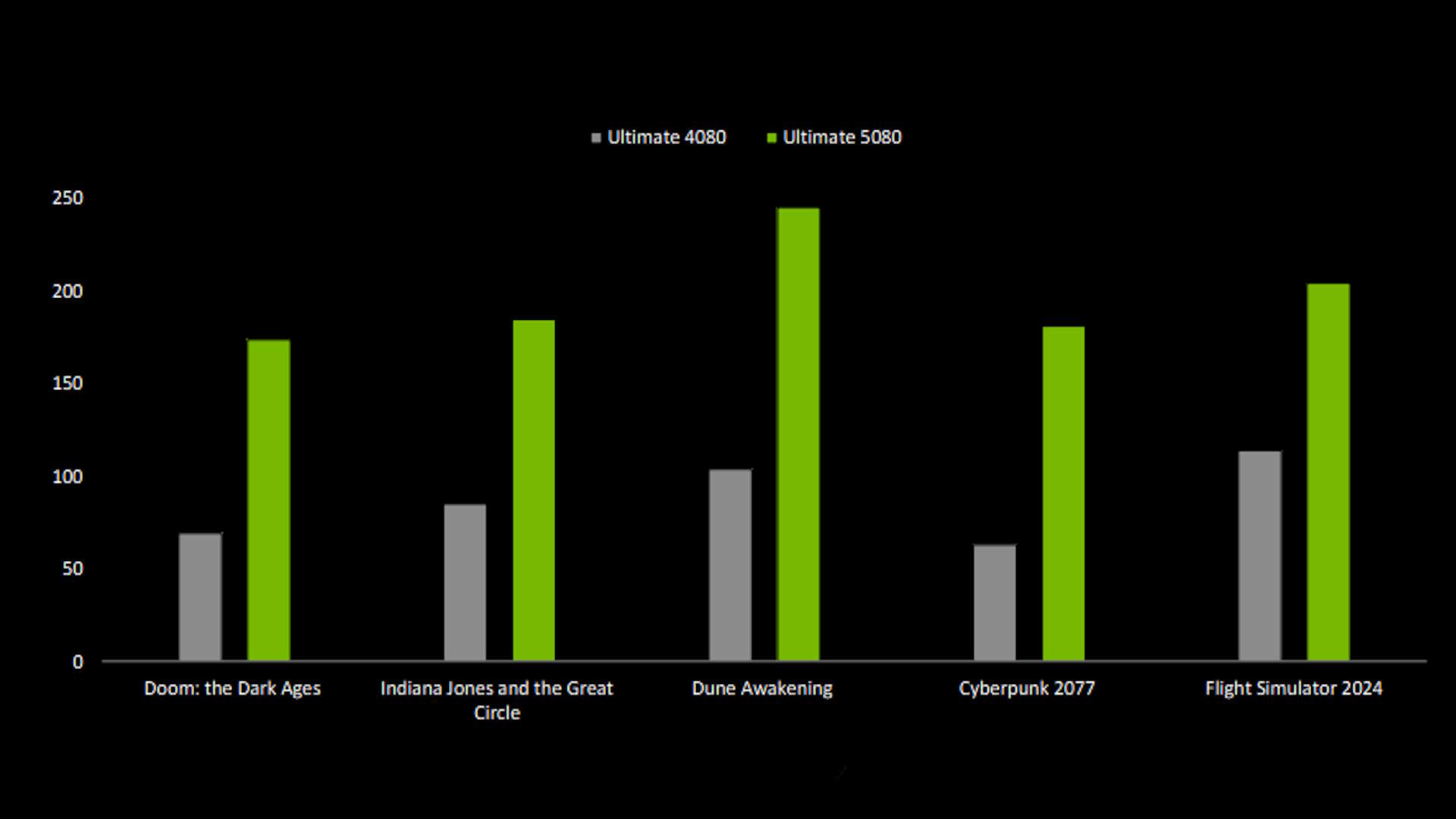Nvidia’s GeForce Now service has been streaming the PC gaming experience to a wide range of devices for over ten years. Today at Gamescom 2025, the company announced the arrival of Blackwell-powered instances on its streaming service, along with a swath of other improvements that are meant to improve latency and image quality.
The biggest upgrade coming to GFN is the deployment of new Blackwell SuperPod servers to the GeForce Now network. The company is promising an RTX 5080-class experience on its Ultimate service tier, compared to the RTX 4080-class experience currently in the top spot. The move to this more powerful shared GPU enables all the features that gamers already expect from Blackwell GPUs, including the full suite of DLSS 4 features and Multi Frame Generation in supported titles.
The company claims its RTX 5080 instances are good for up to a 2.8x increase in output FPS from GeForce Now Ultimate instances compared to the current RTX 4080 hardware, though that figure relies on Blackwell’s Multi-Frame Generation capability for part of the overall boost.

That performance boost is good for new 5K output settings at 60 and 120 FPS, as well as a new 360Hz low-latency mode for competitive gaming.
Beyond the GPU, Nvidia is upgrading the host systems that power GeForce Now instances. Each Ultimate server is now built around a “new Ryzen Threadripper Pro CPU” that will provide each instance with eight cores and 16 threads of CPU horsepower. Nvidia says this upgrade also allows it to double the system memory per server.
Low latency is key to a good GeForce Now experience, and Nvidia highlighted all the ways it’s keeping latency low from server to client. The higher performance of Blackwell GPUs and Threadripper Pro CPUs in each GeForce Now server offers one level of latency reduction, and each server uses the company’s ConnectX 7 smart NICs and Rivermax packet pacing to further minimize latency at a rack level.
NVIDIA has also partnered with Comcast, Deutsche Telekom, and BT Group to take advantage of L4S (Low Latency, Low Loss, and Scalable Throughput) network architectures where they’re available to further reduce lag.
Since GeForce Now is so sensitive to low latency, we asked the company how it considers the input latency added by Multi Frame Generation in its overall evaluation. Nvidia believes that the higher performance of each GeForce Now server for this generation and the full-stack improvements it’s incorporated will help offset the latency added by MFG.
Nvidia emphasizes that gamers have full control over gaming settings on GeForce Now, and if a given player decides that MFG is adding too much latency, they can turn it off.
Nvidia is also introducing a new global quality setting for GeForce Now gameplay called Cinematic Quality Streaming, or CQS. This feature wraps up a whole bundle of improvements, key among them YUV 4:4:4 per-pixel color data, use of the efficient AV1 codec with Reference Picture Resampling support, and up to 100 Mbps of streaming bandwidth.
The company says this suite of improvements should deliver much clearer moving images for discerning users, especially in foliage-heavy scenes that tend to demolish the output image quality of many video encoders.
Install-to-Play and hardware-specific features
Finally, Nvidia is growing the GeForce Now game library with a new Install-to-Play feature, which adds thousands of potential new titles to the service in addition to those that are available to play without an additional download. Assuming a publisher opts into support for this feature, Steam users can purchase a game for their library and then download those titles to a GeForce Now instance during a play session.
Install-to-Play provides 100GB of temporary, per-session storage to Ultimate and Performance subscribers for game installs, and users can purchase persistent storage in tiers of 200GB, 500GB, and 1TB in the event they want to play the same title in the future without downloading it again in a new session. Persistent storage will also preserve saved game data for titles without Steam Cloud support.
Nvidia also announced a range of other improvements to the GeForce Now ecosystem. On the Steam Deck, Ultimate users will now be able to stream games at up to 90 FPS, while Lenovo Legion Go S owners will be able to stream at up to 120 FPS in both handheld and docked modes.
LG TV and monitor owners will be able to enjoy up to 4K 120 FPS streams with HDR enabled, while owners of LG monitors with 5K horizontal resolutions will be able to stream GFN games at up to 120Hz. And owners of Logitech racing wheels with haptics will now be able to take that hardware for a spin in supported GFN titles.
All the Blackwell-powered GeForce Now improvements will come to the Ultimate tier starting in September, without any price increases over existing service tiers. The Ultimate tier will continue to cost $19.99 per month, $99.99 for six months, or $199.99 per year, while Performance memberships will continue to run $9.99 per month, $49.99 for six months, or $99.99 per year.
Follow Tom’s Hardware on Google News to get our up-to-date news, analysis, and reviews in your feeds. Make sure to click the Follow button.
